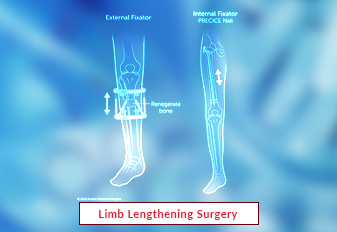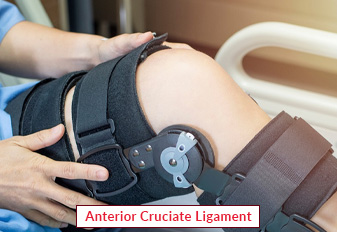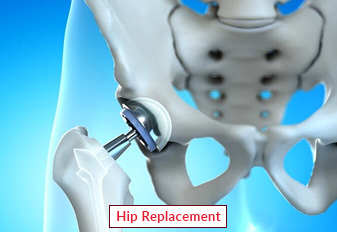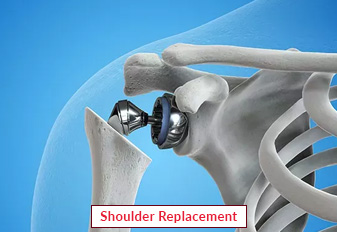Limb Lengthening Surgery

Limb lengthening is a surgical procedure to increase the length of bones, typically in the legs or arms. It involves making controlled fractures in the bone and gradually separating them using an external or internal device. As the bones heal, new bone tissue fills the gap, lengthening the limb. This process of Limb Lengthening Surgery, called distraction osteogenesis, allows for gradual and controlled bone growth. Limb lengthening is used to address congenital limb length differences, correct deformities, or compensate for injuries.
Book an AppointmentAbout Limb Lengthening Surgery
One surgical procedure that can lessen or address limb-length disparities is limb lengthening. The procedure lengthens the bone in the patient's arm or leg and stretches the ligaments, tendons, and muscles that surround it. For patients and families, limb lengthening is a physically taxing and time-consuming procedure. Differences in the length of the arms or legs are corrected via limb lengthening surgery. Additionally, it can treat certain diseases that result in decreased bone length or uneven bone growth.
Limb lengthening surgery treats discrepancies in the length of arms or legs. It can also treat some conditions that cause bone growth irregularities or shorter bone length.
Risks Of Limb-Lengthening Surgery:
Limb lengthening surgery is a complex orthopedic procedure that carries certain risks and potential complications, as any surgical intervention does. Patients considering this surgery should be aware of the following risks:
- Infection: There is a risk of infection at the site of the surgical incisions, as external or internal fixation devices are used. This risk can be mitigated through strict adherence to sterile procedures.
- Delayed or Nonunion: The bones may not heal properly, leading to delayed union or nonunion. This can necessitate additional surgeries to correct or enhance the healing process.
- Nerve or Blood Vessel Damage: During Limb Lengthening Surgery, nerves or blood vessels near the lengthening site may be damaged, potentially causing numbness, weakness, or bleeding.
- Joint Stiffness: Limb lengthening can result in joint stiffness and reduced range of motion. Physical therapy is crucial to prevent this.
- Pain and Discomfort: Patients may experience pain and discomfort during the lengthening phase, especially when adjustments to the device are made.
- Device Complications: External fixation devices, like the Ilizarov apparatus, can cause skin irritation, pin tract infections, and discomfort during the lengthening process.
- Uneven Limb Length: Achieving precise and equal limb lengthening can be challenging, and minor discrepancies may persist after the procedure.
Procedure of Limb Lengthening Surgery
Limb lengthening surgery is a complex orthopedic procedure designed to address limb length discrepancies, deformities, or to increase a patient's height. This intricate Limb Lengthening Surgery involves precise planning, meticulous execution, and a period of rehabilitation.
During the procedure, limb lengthening surgery involves two main steps. Your surgeon:
- Performs an osteotomy, cutting the affected bone into two segments.
- Attaches a limb lengthening device to the two segments of bone.
Your limb-lengthening device will be one of two options:
- External fixator: Using wires or pins, your surgeon fastens a light, thin metal frame to the bones. The majority of the gadget and the frame are external to the body. The majority of these devices protrude several inches from your body, making it challenging to wear certain outfits.
- Internal rod: This newer option is a screw-like device that your surgeon places inside the bone. This device isn’t visible outside the body.
- Here's a detailed overview of the procedure in eight key points:
- Patient Evaluation: Before proceeding with limb lengthening surgery, a thorough evaluation is conducted. This includes a comprehensive medical history review, physical examination, and diagnostic imaging (X-rays, CT scans, or MRIs) to assess the limb's condition, bone quality, and deformity.
- Preoperative Planning: Orthopedic surgeons work closely with the patient to develop a customized treatment plan. This plan outlines the goals of the Limb Lengthening Surgery, the desired lengthening amount, and the specific limb that requires adjustment.
- Anesthesia: Limb lengthening surgery is performed under either general anesthesia (where the patient is unconscious) or regional anesthesia (spinal or epidural) to numb the lower part of the body. The choice depends on the specific procedure and patient preference.
- Bone Cuts: The surgeon makes precise bone cuts at the targeted site. These cuts create two bone segments: the proximal and distal segments. The bone cuts are carefully planned to ensure they align properly during the lengthening process.
- Fixation Device Placement: A fixation device, such as the Ilizarov apparatus or an intramedullary nail, is attached to the bone segments. This device may have external or internal components. In external fixation, pins or wires are inserted through the skin and connected to an external frame. Internal fixation involves the placement of a nail or rod inside the bone.
- Gradual Lengthening: Limb Lengthening Surgery process begins after a latency period, typically several days after surgery. Patients or their caregivers are responsible for turning screws or adjusting the device as per the surgeon's instructions. This gradual lengthening encourages bone regeneration at the separation site.
- Healing and Consolidation: Over several weeks to months, the bone gradually heals and consolidates. New bone tissue forms in the gap created during the lengthening process. Regular X-rays are used to monitor progress and ensure proper alignment.
- Removal of Fixation Device: Once the desired length is achieved, the fixation device is removed in a separate procedure. Afterward, rehabilitation and physical therapy are essential to regain strength, mobility, and function in the lengthened limb.
Require Assistance?
Get A Quick Callback From Our Healthcare Experts
Other Specilities We Cover

Anterior Cruciate Ligament (ACL)

Hip Replacement




